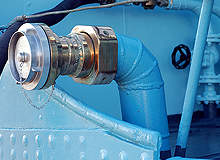
Thanks to bilateral agreements between Greece, Turkey and Italy, the Turkey-Greece-Italy pipeline project is now a reality. Known as Interconnection Turkey Greece Italy (ITGI), the project will supply natural gas from the Caspian Sea and the Middle East to Europe.
The collaborative agreement to build and manage the pipeline was signed by the representatives of the three countries in July 2007 in Rome. The project has been given top priority by the European Commission.
The European Union has also proposed to fund €100m for the ITGI project, calling it a “project of European interest” in the European recovery plan.
The ITGI project includes three segments, including expansion of the Turkish national grid for transmitting natural gas to Italy and Turkey, building a pipeline between Turkey and Greece, and building a further pipeline between Greece and Italy.
The pipeline between Turkey and Greece is known as Interconnector Turkey Greece (ITG). The pipeline between Greece and Italy is known as Interconnector Greece Italy (IGI).
The project will also include a bypass line between Greece and Bulgaria. Known as Interconnector Greece Bulgaria (IGB), it will have a transmission capacity of three to five billion cubic meters of natural gas per annum.
The ITGI project is scheduled to be operational by 2015.
ITGI construction and infrastructure
The 296km-long and 32in-diameter TG pipeline was inaugurated in November 2007. It can transmit 11.5 billion cubic metres of natural gas annually, shared between Italy and Greece. The pipeline required an investment of €118m for the Greek section and €165m for the Turkish section. The EU financed 50% of the cost of technical studies and 29% of the construction costs. The Greek state financed 29% of the construction costs.
Italy and Greece signed an agreement to support the IGI project in November 2005. The 807km-long pipeline will be built in two sections: 207km underwater crossing the Ionian Sea and a 600km ground section. Onshore installations including a fiscal metering station and a compressor station will be installed along the pipeline.
The 207km section, also known as the Poseidon pipeline, will reach a maximum depth of 1,380m. The cost of this is estimated at €500m. IGI Poseidon also includes installation of a compressor station and fiscal metering station in the Greek territory of the pipeline, a fiscal metering and pressure reduction station in the Italian territory of the pipeline, and short onshore pipelines connecting the Greek and Italian stations to their respective landfalls.
The 600km section is an onshore pipeline named as IGI Onshore built by DESFA, which operates Greece’s national natural gas system. DESFA is a subsidiary of DEPA.
Interconnector Greece-Bulgaria bypass line will be 160km long and will transport natural gas from the Southern Gas Corridor to Bulgaria and the Balkans. Expected to be operational from 2013, the bypass line would require an investment of €140m. The European Union has agreed to fund €45m for the project.
Pipeline route
The Turkey Greece interconnector originates in Karacabey in Turkey and reaches Komotini in Greece via Alexandroupolis.
The Italy Greece interconnector will begin from the Thesprotia coast in Greece. It will make a landfall in Otranto in the Apulia region of Italy before ending at Komotini.
The Greece Bulgaria bypass line will begin at Komotini in Greece and end at Stara Zagora in Bulgaria.
Turkey-Greece pipeline partners
The Turkey-Greece interconnector was built by DEPA (public gas corporation) in partnership with Botas (Turkish state gas company).
The 207km section of the Greece-Italy interconnector is being developed by IGI Poseidon, a joint venture set up for the purpose by Edison International and DEPA. Edison will share 80% transmission capacity while DEPA will share the remaining costs. The Italian government has authorised Edison and Depa to use the entire initial transmission capacity of the offshore segment of the IGI pipeline for 25 years.
DESFA, which is building the 600km section of the Greece Italy interconnector, signed a cooperative agreement with IGI Poseidon for the project on 14 July 2010.
The IGB line will be built by a joint venture company to be set up by Bulgarian Energy Holding and IGI Poseidon. The agreement to incorporate the 50:50 JV was finalised by the two partners on 4 March 2010.
Design and contractors
The front-end engineering design contract for the IGI Poseidon was awarded to INTECSEA / IV-Oil & Gas Consortium in May 2010. The 207km section of the IGI pipeline will have a 32in diameter and able to withstand up to 150bar pressure. It will be able to transmit 10bcm of natural gas annually.
The 600km section will have a 42in diameter and able to withstand up to 80bar pressure. It will have the capacity to transmit 15 billion cubic metres of natural gas a year.

